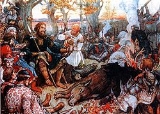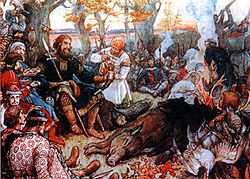
Druzhina
Encyclopedia

Slavic Europe
Slavic Europe is a region of Europe where Slavic languages are spoken. This area is situated in Central and Eastern Europe and the Balkans, and includes the nations of Belarus, Bosnia and Herzegovina, Bulgaria, Croatia, the Czech Republic, the Republic of Macedonia, Montenegro, Poland, Russia,...
was a retinue
Retinue
A retinue is a body of persons "retained" in the service of a noble or royal personage, a suite of "retainers".-Etymology:...
in service of a chieftain
Tribal chief
A tribal chief is the leader of a tribal society or chiefdom. Tribal societies with social stratification under a single leader emerged in the Neolithic period out of earlier tribal structures with little stratification, and they remained prevalent throughout the Iron Age.In the case of ...
, also called knyaz
Knyaz
Kniaz, knyaz or knez is a Slavic title found in most Slavic languages, denoting a royal nobility rank. It is usually translated into English as either Prince or less commonly as Duke....
. The name is derived from the Slavic word drug (друг) with the meaning of "companion, friend".
Early Rus
In early Rus a druzhina helped the a princePrince
Prince is a general term for a ruler, monarch or member of a monarch's or former monarch's family, and is a hereditary title in the nobility of some European states. The feminine equivalent is a princess...
administer his principality
Principality
A principality is a monarchical feudatory or sovereign state, ruled or reigned over by a monarch with the title of prince or princess, or by a monarch with another title within the generic use of the term prince....
and constituted the area’s military force. The first members of a druzhina in Rus Khaganate were the Varangians
Varangians
The Varangians or Varyags , sometimes referred to as Variagians, were people from the Baltic region, most often associated with Vikings, who from the 9th to 11th centuries ventured eastwards and southwards along the rivers of Eastern Europe, through what is now Russia, Belarus and Ukraine.According...
, whose princes established control there in the 9th century. Soon members of the local Slavic aristocracy as well as adventurers of a variety of other nationalities became druzhinniki. The druzhina organization varied with time and survived in one form or another until the 16th century.
The druzhina was composed of two groups: the senior members, later known as boyars
Boyar
A boyar, or bolyar , was a member of the highest rank of the feudal Moscovian, Kievan Rus'ian, Bulgarian, Wallachian, and Moldavian aristocracies, second only to the ruling princes , from the 10th century through the 17th century....
, and the junior members. The boyars were the prince’s closest advisers who also performed higher state functions. The junior members constituted the prince’s personal bodyguard and were common soldiers. Members were dependent upon their prince for financial support, but they served the prince freely and had the right to leave him and join the druzhina of another prince. As a result, a prince was inclined to seek the goodwill of his druzhina by paying the druzhinniki wages, shared his war booty and taxes with them, and eventually rewarded the boyars with landed estates, complete with rights to tax and administer justice to the local population.
At the Battle of Lake Peipus the army of the Novgorod Republic
Novgorod Republic
The Novgorod Republic was a large medieval Russian state which stretched from the Baltic Sea to the Ural Mountains between the 12th and 15th centuries, centred on the city of Novgorod...
had about 5000 men in all, and around 3000 men in both the cavalry and infantry were part of Alexander Nevsky
Alexander Nevsky
Alexander Nevsky was the Prince of Novgorod and Grand Prince of Vladimir during some of the most trying times in the city's history. Commonly regarded as the key figure of medieval Rus, Alexander was the grandson of Vsevolod the Big Nest and rose to legendary status on account of his military...
's druzhina.
Poland
Abraham ben JacobAbraham ben Jacob
Abraham ben Jacob, better known under his Arabic name of Ibrâhîm ibn Ya`qûb was a 10th century Hispano-Arabic, plausibly Sephardi Jewish, traveller, probably a merchant, whose brief may have included diplomacy and espionage...
, who traveled in 961–62 in Central Europe
Central Europe
Central Europe or alternatively Middle Europe is a region of the European continent lying between the variously defined areas of Eastern and Western Europe...
, mentions that the drużyna of Polish
Poland
Poland , officially the Republic of Poland , is a country in Central Europe bordered by Germany to the west; the Czech Republic and Slovakia to the south; Ukraine, Belarus and Lithuania to the east; and the Baltic Sea and Kaliningrad Oblast, a Russian exclave, to the north...
Mieszko I
Mieszko I of Poland
Mieszko I , was a Duke of the Polans from about 960 until his death. A member of the Piast dynasty, he was son of Siemomysł; grandchild of Lestek; father of Bolesław I the Brave, the first crowned King of Poland; likely father of Świętosława , a Nordic Queen; and grandfather of her son, Cnut the...
had 3000 men, paid by a duke.
Archeological findings at cemeteries in the vicinity of the castle of Ostrów Lednicki
Ostrów Lednicki
Ostrów Lednicki is a castle in Poland built in medieval times on an island on Lake Lednica. The castle is thought to be the home of the first Kings of the Piast dynasty. Today the ruins are of archaeological significance. Ostrów Lednicki is located between Gniezno and Poznań....
, near Poznan
Poznan
Poznań is a city on the Warta river in west-central Poland, with a population of 556,022 in June 2009. It is among the oldest cities in Poland, and was one of the most important centres in the early Polish state, whose first rulers were buried at Poznań's cathedral. It is sometimes claimed to be...
, has proven the presence of Norsemen
Norsemen
Norsemen is used to refer to the group of people as a whole who spoke what is now called the Old Norse language belonging to the North Germanic branch of Indo-European languages, especially Norwegian, Icelandic, Faroese, Swedish and Danish in their earlier forms.The meaning of Norseman was "people...
in the area around 10th century, suggesting that they played an important part the druzhina of Mieszko I
Mieszko I of Poland
Mieszko I , was a Duke of the Polans from about 960 until his death. A member of the Piast dynasty, he was son of Siemomysł; grandchild of Lestek; father of Bolesław I the Brave, the first crowned King of Poland; likely father of Świętosława , a Nordic Queen; and grandfather of her son, Cnut the...
, the de facto
De facto
De facto is a Latin expression that means "concerning fact." In law, it often means "in practice but not necessarily ordained by law" or "in practice or actuality, but not officially established." It is commonly used in contrast to de jure when referring to matters of law, governance, or...
founder of the Polish state
Poland
Poland , officially the Republic of Poland , is a country in Central Europe bordered by Germany to the west; the Czech Republic and Slovakia to the south; Ukraine, Belarus and Lithuania to the east; and the Baltic Sea and Kaliningrad Oblast, a Russian exclave, to the north...
. Mieszko
Mieszko I of Poland
Mieszko I , was a Duke of the Polans from about 960 until his death. A member of the Piast dynasty, he was son of Siemomysł; grandchild of Lestek; father of Bolesław I the Brave, the first crowned King of Poland; likely father of Świętosława , a Nordic Queen; and grandfather of her son, Cnut the...
would later marry his daughter Świętosława (Sigrid)
Sigrid the Haughty
Sigrid the Haughty, also known as Sigríð Storråda, is a queen appearing in Norse sagas as wife, first of Eric the Victorious of Sweden, then Sweyn Forkbeard of Denmark. While given the Nordic ancestry in sagas, she has been hypothesized to be identical to historically attested Polish or Pomeranian...
to the Danish
Denmark
Denmark is a Scandinavian country in Northern Europe. The countries of Denmark and Greenland, as well as the Faroe Islands, constitute the Kingdom of Denmark . It is the southernmost of the Nordic countries, southwest of Sweden and south of Norway, and bordered to the south by Germany. Denmark...
king Sweyn Forkbeard. Mieszko's
Mieszko I of Poland
Mieszko I , was a Duke of the Polans from about 960 until his death. A member of the Piast dynasty, he was son of Siemomysł; grandchild of Lestek; father of Bolesław I the Brave, the first crowned King of Poland; likely father of Świętosława , a Nordic Queen; and grandfather of her son, Cnut the...
daughter would later give birth to Cnut the Great, king of Denmark
Denmark
Denmark is a Scandinavian country in Northern Europe. The countries of Denmark and Greenland, as well as the Faroe Islands, constitute the Kingdom of Denmark . It is the southernmost of the Nordic countries, southwest of Sweden and south of Norway, and bordered to the south by Germany. Denmark...
, Sweden
Sweden
Sweden , officially the Kingdom of Sweden , is a Nordic country on the Scandinavian Peninsula in Northern Europe. Sweden borders with Norway and Finland and is connected to Denmark by a bridge-tunnel across the Öresund....
, Norway
Norway
Norway , officially the Kingdom of Norway, is a Nordic unitary constitutional monarchy whose territory comprises the western portion of the Scandinavian Peninsula, Jan Mayen, and the Arctic archipelago of Svalbard and Bouvet Island. Norway has a total area of and a population of about 4.9 million...
and conqueror of England
England
England is a country that is part of the United Kingdom. It shares land borders with Scotland to the north and Wales to the west; the Irish Sea is to the north west, the Celtic Sea to the south west, with the North Sea to the east and the English Channel to the south separating it from continental...
. It is likely that the Polish
Poland
Poland , officially the Republic of Poland , is a country in Central Europe bordered by Germany to the west; the Czech Republic and Slovakia to the south; Ukraine, Belarus and Lithuania to the east; and the Baltic Sea and Kaliningrad Oblast, a Russian exclave, to the north...
-Norse
Norsemen
Norsemen is used to refer to the group of people as a whole who spoke what is now called the Old Norse language belonging to the North Germanic branch of Indo-European languages, especially Norwegian, Icelandic, Faroese, Swedish and Danish in their earlier forms.The meaning of Norseman was "people...
relationship was a result of earlier trade and cooperation.
See also
- HousecarlHousecarlIn medieval Scandinavia, housecarls and sometimes spelled huscarle or houscarl) were either non-servile manservants, or household troops in personal service of someone, equivalent to a bodyguard to Scandinavian lords and kings. This institution also existed in Anglo-Saxon England after its...
- LeidangLeidangThe institution known as leiðangr , leidang , leding, , ledung , expeditio or sometimes lething , was a public levy of free farmers typical for medieval Scandinavians. It was a form of conscription to organise coastal fleets for seasonal excursions and in defence of the realm...
- HirdHirdThe hird, in Norwegian history, was originally an informal retinue of personal armed companions, hirdmen or housecarls, but came to mean not only the nucleus of the royal army, but also developed into a more formal royal court household....
- Voluntary People's DruzhinaVoluntary People's DruzhinaVoluntary People's Druzhina variously translated as Voluntary People’s Guard, People’s Volunteer Squads, People's Volunteer Militia, etc. were voluntary detachments for maintaining public order in the Soviet Union similar to the Neighborhood Watch...
, a civilian organization in the Soviet UnionSoviet UnionThe Soviet Union , officially the Union of Soviet Socialist Republics , was a constitutionally socialist state that existed in Eurasia between 1922 and 1991....

